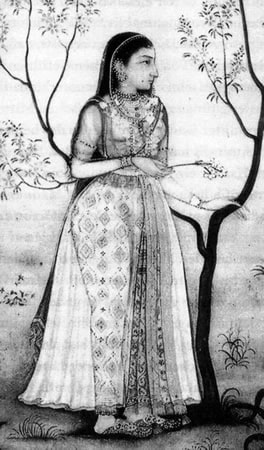The Mughals of India ruled over one of the greatest empires in human history. In Milton’s Paradise Lost, the Mughal cities of Agra and Lahore are revealed to Adam after the Fall as future wonders for God’s creation.

Popular myth has made us believe that Mughal women were confined to a secluded harem, where a lascivious emperor preyed upon scores of nubile women. The truth, however, is that Mughal women were just as invested as the men in empire building. Women like Noor Jahan and Harkha Bai played a prominent role in developing military strategy, creating art and designing some of the most stunning buildings known to humankind.
Here are five surprising facts about the Mughal Princess Jahanara, the eldest child of Emperor Shah Jahan (who built the Taj Mahal in honor of his wife Mumtaz Mahal). Jahanara is largely forgotten today – however she was a true renaissance woman, who was an author, architect and mystic par excellence.
1. Jahanara was “First Lady” of the Mughal Empire
As the Padhsah Begum (aka the “First Lady”), Jahanara was responsible for the trade with the English and the Dutch. Her ship the Sahibi set sail from the Indian port of Surat. Jahanara’s annual income was 300,000 rupees, or 21 million dollars in today’s money.
As the Padshah Begun, she was responsible for affixing the imperial seal to all royal edicts.
2. Mughal Princess Jahanara Was a Respected Author
Jahanara had a strong interest in Sufism, and was one of the most respected authors of her time.
Her biography of the Indian Chishti Sufi order “The Confidant of Spirits” is highly regarded for its literary quality. The book’s conclusion tells of her spiritual journey at the mausoleum of a revered Chishti saint.
Jahanara also compiled commentaries of Rumi’s Mathnawi – one of the most pouplar mystical books to date.
3. Jahanara Was an Accomplished Architect
When Shah Jahan moved his capital to Delhi, Jahanara was responsible for five of the nineteen Imperial buildings built in the city.
She laid out the iconic central bazaar of Chandni Chowk, India’s Champs Elysees, was built fifteen years before the French. The Indian government plans to restore Chandni Chowk back to its former glory in 2020.
4. Jahanara Was Highly Educated
Jahanara received an education in classical Persian.
She placed a great emphasis of learning. When her teacher Satti Khannum died, Jahanara build an octagonal mausoleum for her near the Taj Mahal.
However, even though she was highly erudite, she enjoyed the finer things in life. She loved to drink her own blend of wine mixed with rose water.
5. Mughal Princess Jahanara Built Her Own Tomb
Jahanara built her tomb during her lifetime near the mausoleum of her favorite Sufi saint. In keeping with her adoration for the austere Sufi saints, her grave is simple and open to the sky. On it are the words:
Let no one cover my grave except with greenery,
For this very grass suffices as a tomb cover for the poor.







Leave a Reply